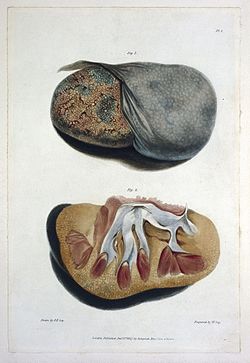Bright's disease
Editor-In-Chief: Prab R Tumpati, MD
Obesity, Sleep & Internal medicine
Founder, WikiMD Wellnesspedia &
W8MD medical weight loss NYC and sleep center NYC
| Bright's disease | |
|---|---|

| |
| Synonyms | N/A |
| Pronounce | N/A |
| Specialty | N/A |
| Symptoms | Edema, hypertension, proteinuria, hematuria |
| Complications | Chronic kidney disease, heart failure, hypertensive crisis |
| Onset | Varies |
| Duration | Chronic |
| Types | N/A |
| Causes | Various kidney diseases, including glomerulonephritis |
| Risks | Infection, autoimmune disease, diabetes mellitus, hypertension |
| Diagnosis | Urinalysis, blood test, kidney biopsy |
| Differential diagnosis | Nephrotic syndrome, nephritic syndrome, acute kidney injury |
| Prevention | N/A |
| Treatment | Antihypertensive, diuretics, immunosuppressive drugs |
| Medication | N/A |
| Prognosis | Variable, depending on underlying cause |
| Frequency | Rare (as a historical term) |
| Deaths | N/A |
| Bright's Disease | |
|---|---|
| ICD-10 | N00-N08 |
| ICD-9 | 582 |
| DiseasesDB | 1914 |
| MedlinePlus | 000464 |
| eMedicine | |
| MeSH ID | D001919 |
Bright's disease is a historical classification of kidney diseases that would be described in modern medicine as acute or chronic nephritis. The term is no longer used, as diseases are now classified according to their more fully understood etiologies.
Historical Context
Bright's disease is named after Richard Bright, who described the condition in the early 19th century. He identified it as a disease with symptoms of edema, proteinuria, and hypertension with kidney damage.
Symptoms
Bright's disease could present a range of symptoms, most notably: Edema, or swelling, particularly in the face and lower extremities Proteinuria, or protein in the urine Hypertension, or high blood pressure
Diagnosis
In the modern context, the diagnoses previously grouped under Bright's disease would be differentiated based on more specific criteria, such as:
Treatment
Treatment would be specific to the particular kidney condition diagnosed. These could range from medication to manage symptoms, lifestyle changes, or in severe cases, dialysis or kidney transplant.
Summary
While Bright's disease is no longer a term used in modern medicine, its history provides insight into the evolution of medical understanding of kidney diseases. Today, doctors can more accurately diagnose and treat the conditions once collectively known as Bright's disease.
See Also
Transform your life with W8MD's budget GLP-1 injections from $125.
W8MD offers a medical weight loss program to lose weight in Philadelphia. Our physician-supervised medical weight loss provides:
- Most insurances accepted or discounted self-pay rates. We will obtain insurance prior authorizations if needed.
- Generic GLP1 weight loss injections from $125 for the starting dose.
- Also offer prescription weight loss medications including Phentermine, Qsymia, Diethylpropion, Contrave etc.
NYC weight loss doctor appointments
Start your NYC weight loss journey today at our NYC medical weight loss and Philadelphia medical weight loss clinics.
- Call 718-946-5500 to lose weight in NYC or for medical weight loss in Philadelphia 215-676-2334.
- Tags:NYC medical weight loss, Philadelphia lose weight Zepbound NYC, Budget GLP1 weight loss injections, Wegovy Philadelphia, Wegovy NYC, Philadelphia medical weight loss, Brookly weight loss and Wegovy NYC
|
WikiMD's Wellness Encyclopedia |
| Let Food Be Thy Medicine Medicine Thy Food - Hippocrates |
Medical Disclaimer: WikiMD is not a substitute for professional medical advice. The information on WikiMD is provided as an information resource only, may be incorrect, outdated or misleading, and is not to be used or relied on for any diagnostic or treatment purposes. Please consult your health care provider before making any healthcare decisions or for guidance about a specific medical condition. WikiMD expressly disclaims responsibility, and shall have no liability, for any damages, loss, injury, or liability whatsoever suffered as a result of your reliance on the information contained in this site. By visiting this site you agree to the foregoing terms and conditions, which may from time to time be changed or supplemented by WikiMD. If you do not agree to the foregoing terms and conditions, you should not enter or use this site. See full disclaimer.
Credits:Most images are courtesy of Wikimedia commons, and templates, categories Wikipedia, licensed under CC BY SA or similar.
Contributors: Prab R. Tumpati, MD

